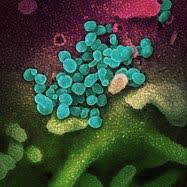Which impact for proton pump inhibitors in SARS-CoV-2 pneumonia

Submitted: February 14, 2021
Accepted: June 8, 2021
Published: October 19, 2021
Accepted: June 8, 2021
Abstract Views: 1200
PDF: 547
Publisher's note
All claims expressed in this article are solely those of the authors and do not necessarily represent those of their affiliated organizations, or those of the publisher, the editors and the reviewers. Any product that may be evaluated in this article or claim that may be made by its manufacturer is not guaranteed or endorsed by the publisher.
All claims expressed in this article are solely those of the authors and do not necessarily represent those of their affiliated organizations, or those of the publisher, the editors and the reviewers. Any product that may be evaluated in this article or claim that may be made by its manufacturer is not guaranteed or endorsed by the publisher.
Similar Articles
- Alice Biffi, Giulia Dei, Federica De Giacomi, Anna Stainer, Lorenzo Olmo Parma, Maria Rosa Pozzi, Paola Faverio, Alberto Pesci, Non-specific interstitial pneumonia and features of connective tissue disease: What are the consequences of a different point of view? , Monaldi Archives for Chest Disease: Vol. 88 No. 3 (2018)
- Gianfranco Beghi, Antonio De Tanti, Paolo Serafini, Chiara Bertolino, Antonietta Celentano, Graziella Taormina, Monitoring of hospital acquired pneumonia in patients with severe brain injury on first access to intensive neurological rehabilitation: First year of observation , Monaldi Archives for Chest Disease: Vol. 88 No. 1 (2018)
- Amrutha S, Komaldeep Kaur, Deepak Aggarwal, Mandeep Kaur Sodhi, Shivani Jaswal, Varinder Saini, Serial evaluation of antibody titres in patients recovered from COVID-19 and their correlation with disease severity , Monaldi Archives for Chest Disease: Vol. 94 No. 4 (2024)
- M. Confalonieri, M. Kodric, M. Santagiuliana, C. Longo, M. Biolo, R. Cifaldi, C. Torregiani, M. Jevnikar, To use or not to use corticosteroids for pneumonia? A clinician’s perspective , Monaldi Archives for Chest Disease: Vol. 77 No. 2 (2012): Pulmonary series
- S. Al-Muhairi, T. Zoubeidi, M. Ellis, M. Gary Nicholls, W. Safa, J. Joseph, Demographics and microbiological profile of Pneumonia in United Arab Emirates , Monaldi Archives for Chest Disease: Vol. 65 No. 1 (2006): Pulmonary series
- Branko Beronja, Aleksandra Karan, Biljana Lukic, Ivana Milosevic, Jelena Dotlic, Tatjana Gazibara, Smoking patterns and outcomes of severe sars-CoV-2 infection: a retrospective cohort study , Monaldi Archives for Chest Disease: Early Access
- Angel Estella, Usefulness of CURB-65 and Pneumonia Severity Index for Influenza A H1N1v pneumonia , Monaldi Archives for Chest Disease: Vol. 77 No. 3-4 (2012): Pulmonary series
- Neeta Singla, Amitesh Gupta, U.K. Khalid, Ravindra Kumar Dewan, Rupak Singla, Clinical profile, risk factors, disease severity, and outcome for COVID-19 disease in patients with tuberculosis on treatment under the National Tuberculosis Elimination Program: a cohort of 1400 patients , Monaldi Archives for Chest Disease: Early Access
- Chi Fong Wong, See Wan Yan, Wai Mui Wong, Ronnie S.L. Ho, Exogenous lipoid pneumonia associated with oil pulling: Report of two cases , Monaldi Archives for Chest Disease: Vol. 88 No. 3 (2018)
- P.A. Canessa, L. Pratticò, M. Sivori, P. Magistrelli, F. Fedeli, A. Cavazza, G. Calcina, Acute Fibrinous and Organising Pneumonia in Whipple’s disease , Monaldi Archives for Chest Disease: Vol. 69 No. 4 (2008): Pulmonary series
You may also start an advanced similarity search for this article.

 https://doi.org/10.4081/monaldi.2021.1803
https://doi.org/10.4081/monaldi.2021.1803





